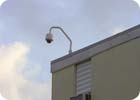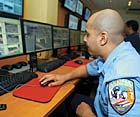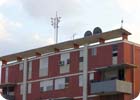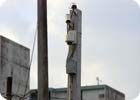
Dome cameras look over the public housing facilities in the Commonwealth of Puerto Rico.
More than 350,000 public housing residents in Puerto Rico sleep easier these days knowing that, in addition to the on-site physical police force, a virtual police force now watches their complex all the time. What began two years ago as a pilot project has grown to become a model intelligent system for public housing.
“Security in public housing is a challenging issue involving lots of complex social problems and law enforcement,” said Carlos Laboy, executive director, Vivienda Public Housing, the largest public housing system in the Commonwealth of Puerto Rico, second only to New York City. “We did a lot of research on security throughout the U.S. and Europe and determined exactly what we needed to improve the quality of life for our residents.”

Images are recorded locally but also monitored through a central command center.
The latter provided an embedded video analytics component to further enhance the proposed solution, where analytics enables rules-based people detection, classification, tracking and real-time alerting. Each camera installed features video analytics, resulting in a completely automatic system to assist police officers. A video sentinel server is the video management platform engine, driving live and recorded video, controlling encoders and providing user access control and a map-based graphic viewer provides access cameras with MPEG4 images.

The aim of the cameras and intelligent software is to gather information on what’s happening at the public housing facilities.
HOW IT WORKS
“Our solution now includes intelligent monitoring because of the video analytics component,” said Alberto Diaz of Avant Technologies. “What that means is that police can detect, classify and track suspicious individuals in real-time and address potential security concerns as they’re happening.”Within each housing complex, cameras provide real-time recording, and the video feeds are analyzed by intelligent software that can distinguish between cars and people. To ensure residents’ privacy is maintained, the cameras use a special window blanking technology as they record activity throughout the public housing area. Monitored centrally day and night, the cameras are meant to be a preventative measure against crime. Suspicious information is identified and recorded locally at a high resolution and then immediately sent to a centralized facility/video retention center where it’s used to evaluate criminal activity or saved for future use in court. When an alert occurs, the remote guard can easily obtain that camera’s high resolution video over the wide-area network.
The centralized information provides great efficiencies by eliminating redundancies, improving communication and increasing shared knowledge among police and other public safety officials. Recorded video can be used as evidence in criminal investigations and can reduce the associated costs to the government.
The video server, a special fully networked digital encoder/analytics unit, centralizes the large number of cameras in use. This multiple rack-mounted chassis includes a wide-array of interfacing devices for remote alarm monitoring, device control and remote data acquisition, which is important for such a distributed surveillance system. The unit is a fully programmable and upgradeable platform that allows multi-server administration capabilities.
“In addition to helping us reduce crime, the intelligent video surveillance system has enabled us to improve communication throughout our police force and centralize our public housing issues,” said Laboy.

Numerous types of cameras, hung from posts throughout the development, provide virtual police protection day and night.
WHAT’S NEXT?
A stroll through Puerto Rico’s public housing complexes today is much different than it was before the sophisticated security surveillance system was in place. Today residents are outside more often, feeling safe and protected.The comprehensive security surveillance system comprises 225 cameras in 15 public housing developments in Puerto Rico. Because the system has been recognized as a model public security system, the design is spreading to other areas including public housing complexes in the U.S.
“Our surveillance technology is really aimed at preventing crime,” said Diaz. “With video analytics you get more eyes and therefore increased coverage of potential incidents.”
“It is our hope that our surveillance systems not only help identify and prosecute criminals, but more importantly, serve as a deterrent to crime, to continue to keep our residents safe,” said Laboy.


